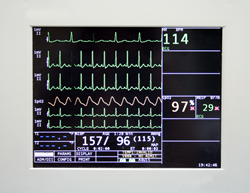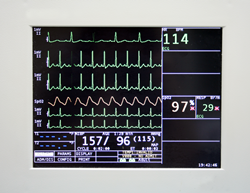
Cardiac episodes are a potential long-term effect for those who recover from COVID-19.
Seventy-three percent of unstructured patient data is inaccessible for analysis.
WALTHAM, Mass. (PRWEB)
August 03, 2020
The current coronavirus pandemic has shown that complete, near real-time health care data is a clear path to improve health outcomes. Achieving that goal moving forward requires that data to be accessible via accurate device and electronic health record (EHR) interoperability. That’s the mantra of leading ambulatory cardiac monitoring provider InfoBionic and a growing healthcare continuum chorus whose true interoperability successes are the roadmap to broader interoperability. “Secure and complete EHR healthcare data sharing will definitely benefit with cloud-based strategies,” InfoBionic CEO Stuart Long said. “But to evolve that journey will require EHR interoperable solutions like full disclosure remote cardiac monitoring and other remote patient monitoring (RPM) solutions to truly begin changing outcomes.”
The Long Road to EHR Interoperability
The first few miles of that electronic health record interoperability journey have been achieved with 96 percent of US hospitals and 86 percent of physician practices now using EHR software.(1)(2) But true interoperability has a long way to go with individual hospitals and health systems using as many as 18 different EHR systems across their facilities and departments.(3) Making matters worse is the fact that 73 percent of unstructured patient data is inaccessible for analysis, which exacerbates the integration and disparate EHR problem and holds back interoperability.(4)
The lack of near real-time access to all-encompassing health condition data makes it nearly impossible to keep up with an evolving pandemic virus. One important aspect of the evolution of knowledge about the virus is that cardiac episodes are a potential long-term effect for those who recover from COVID-19.
The current pandemic has led to broader use of RPM as a means to monitor all types of conditions. The problem is that many solutions lack proven efficacy, the ability to deliver full disclosure data access, and assured integration of that data with EHRs. Many RPM solutions also make it difficult to easily identify the data that requires immediate attention. This is also true of many EHRs that also lack the ability to differentiate and recognize data from disparate sources.(5)
Gaining EHR Interoperability Ground Through RPM and Standards
There is cause for optimism that health care is getting closer to true interoperability. This can be seen with the recent repositioning of The Office of the National Coordinator for Health Information (ONC), Centers for Medicare and Medicaid Services (CMS), and other healthcare regulatory bodies around EHRs. These organizations are at the forefront of the push towards interoperability by transitioning from the meaningful use standard for EHRs to codifying interoperability standards as the benchmark.
In fact, numerous projects like Advancing Standards for Precision Medicine are bringing together major health care organizations to standardize vital sign data language.(6) This is a vital part of interoperability along with application programming interface (API) standardization, universal adoption of Fast Healthcare Interoperability Resources (FHIR) and HL7, and widening of healthcare data types within EHRs.(7)
Wearable health technology and mHealth (mobile health) devices are beginning to explore the viability of EHR interoperability as part of their functionality.(8) The list of ambulatory RPM devices currently spans a limited list of vitals monitoring for things like blood pressure and glucose monitoring among other. The list of RPM devices that have achieved full disclosure of real-time data access and interoperability is even smaller. Although there are certainly RPM devices that monitor the heart, the data that they transmit is often limited in ways that have yet to show efficacy in helping physicians improve health outcomes.
The growing body of evidence shows that COVID-19’s impact on the body’s organs impacts the heart, which can result in healthy people becoming cardiac patients.(9)(10) This is just the tip of the healthcare iceberg showing why remote cardiac monitoring is vital for a broad number of health conditions. The pandemic’s long shadow reveals how RPM in the form of a remote continuous ambulatory cardiac monitor that can ensure full disclosure data and cloud EHR interoperability is vital.
There are clearly a number of gaps that must be bridged to achieve true cloud EHR interoperability, but more providers like InfoBionic are leading the way. “Solutions like the MoMe® Kardia platform are designed to be EHR interoperable along with being versatile to enable transitioning between Holter, Event, and MCT modes remotely”, Long explained. It takes these types of solutions to realize true EHR interoperability that’s simple for ambulatory patients while providing actionable full disclosure health data to the physician, cardiologist and hospitals to improve patient outcomes.”
About InfoBionic
InfoBionic is a digital health company transforming the efficiency and economics of ambulatory remote patient monitoring processes by optimizing clinical and real-world utility for the users that need it most – physicians and their patients. The Massachusetts-based team of seasoned entrepreneurs have had successful careers in healthcare, IT, medical devices and mobile technology, and bring specific expertise in remote monitoring and cardiology. They have seen first-hand the complexities of traditional cardiac arrhythmia detection and monitoring processes and designed the transformative MoMe® Kardia platform to remove the roadblocks hindering faster, more effective diagnosis and decision-making. Frost & Sullivan bestowed the 2019 North American Remote Cardiac Monitoring Technology Leadership Award upon InfoBionic. For more information, visit http://www.infobionic.com.
1. Non-federal Acute Care Hospital Electronic Health Record Adoption, Health IT Dashboard, dashboard.healthit.gov/quickstats/pages/FIG-Hospital-EHR-Adoption.php
2. “Office-based Physician Electronic Health Record Adoption, Health IT Dashboard, dashboard.healthit.gov/quickstats/pages/physician-ehr-adoption-trends.php
3. Tom Sullivan. “Why EHR data interoperability is such a mess in 3 charts,” Healthcare IT News, April 16, 2018, healthcareitnews.com/news/why-ehr-data-interoperability-such-mess-3-charts
4. “Hyland Healthcare and HIMSS Media publish 2020 Connected Care and the State of Interoperability in Healthcare study results,” Hyland Healthcare, April 20, 2020, hyland.com/hyland-healthcare-and-himss-media-publish-2020-connected-care-and-the-state-of-interoperability-in-healthcare-study-results/
5. Nathan Eddy. “Remote patient monitoring to gain big momentum in 2020,” Health IT News, January 21, 2020, healthcareitnews.com/news/remote-patient-monitoring-gain-big-momentum-2020
6. Kevin Chaney et al. “Standards for Everyday Life: Integrating Emerging Health Data to Advance Precision Medicine,” health IT Buzz, April 9, 2020, healthit.gov/buzz-blog/precision-medicine/standards-for-everyday-life-integrating-emerging-health-data-to-advance-precision-medicine
7. Ben Moscovitch. “Widespread Support for Adopting Tools Needed to Tap Potential of Electronic Health Records,” Pew Trust, September 18, 2019, pewtrusts.org/en/research-and-analysis/articles/2019/09/18/widespread-support-for-adopting-tools-needed-to-tap-potential-of-electronic-health-records
8. Catherine Dinh-Le1et al. “Wearable Health Technology and Electronic Health Record Integration: Scoping Review and Future Directions,” JMIR Publications, November 19, 2018, mhealth.jmir.org/2019/9/e12861/
9. Maria Cohut, Ph.D. “New study warns of COVID-19 impact on cardiovascular health,” Medical News Today, May 19, 2020, medicalnewstoday.com/articles/new-study-warns-of-covid-19-impact-on-cardiovascular-health
10. Ekaterina Pesheva. “COVID-19 may spark cardiac trouble in multiple ways,” Harvard Gazette, April 14, 2020, news.harvard.edu/gazette/story/2020/04/covid-19s-consequences-for-the-heart/
Share article on social media or email:

